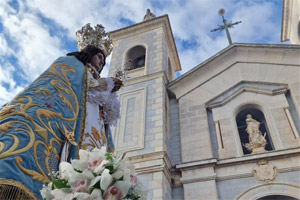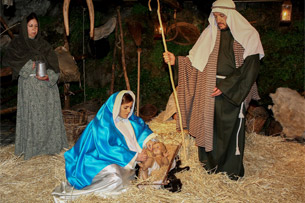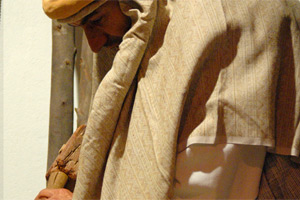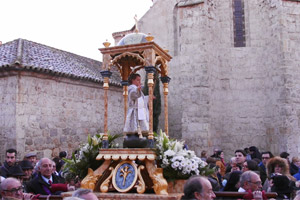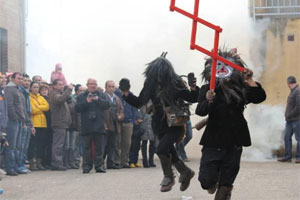Fiestas of the Holy and Vera Cruz in Caravaca de la Cruz
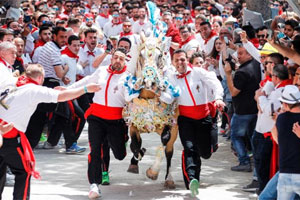
What this ancient festivity consists of
The Festivities of the Holy and Vera Cruz in Caravaca de la Cruz are festivals declared of International Tourist Interest. For five days, the city fills with visitors and vitality, celebrating the feat of a group of Templar knights and the battles between Moors and Christians in border skirmishes with the Nazarí Kingdom of Granada.
The festivity begins on April 30th with the Night of the Migas, where the streets are filled with music and color with the "migueras" (groups of people who prepare migas), who compete for the best plate of migas in the Plaza del Hoyo. On May 1st, events such as the Floral Offering, the Bareback Horse Contest, and the Mantos Exhibition are celebrated.
The most anticipated day is May 2nd, known as the Wine Horses, where thousands of people gather to witness the mythical race that recalls the feat of the Templars who broke the Muslim siege, introduced wine into the city, and saved the people from dying from poisoned water.
To blend in, it is only necessary to wear a red scarf around the neck, a white shirt, and be prepared to attend one of Spain's most thunderous festivals.
Each of the five days of these festivities has its own relevance and idiosyncrasy:
April 30th, Night of the Migas
The Night of the Migas is the eve of the patron saint festivities in Caravaca de la Cruz. It begins with the flowered reveille at 7 in the morning, and at nightfall, the Southeastern Migas Contest is celebrated, where neighbors and groups compete for the first place in this contest. The streets of the old town are filled with music, dance, and a festive atmosphere, making this night one of the liveliest of the festival.
May 1st, Floral Offering
Floral Offering to the Holy Cross in the esplanade of the Vera Cruz Basilica. During the morning, the inhabitants offer flowers that are placed in the form of a cross, symbolizing spring and the city's link to the Region of Murcia.
In the afternoon, bareback horse parades are held, which tour the city showing their different breeds and coats. In the Cuesta de las Quinielas, the horses gallop up in what is a preview of the race the next day. At night, the beauty, strength, and anatomy of the horses are awarded in the Plaza del Hoyo.
May 2, Wine Horses
The Wine Horses is a festival that begins with an early morning mass, after which, the horses are adorned with silk and gold mantles in their respective horsemen groups. Then, the 60 horses and their groups parade through the streets of the city showing off their embroidered mantles and infecting the festive atmosphere. On the way, the Grand Master of the Royal and Illustrious Brotherhood of the Most Holy and True Cross of Caravaca collects a tray of flowers and purifiers made by the Clarisas Mothers and carries it to the Basilica of the True Cross. There, the Historic horse carries the wine in leather bags into the interior of the temple to be blessed along with the flowers delivered to the Patroness the day before.
At the same time, the Wine Horses race takes place, in which four horsemen cling to the horse as it climbs up an 80-meter hill to the castle gate. The one who manages to climb the fastest wins. At the end of the race, the prizes for the Embellishment contest are awarded, which rewards the best embroidered mantle. The celebration of the Wine Horses lasts until five in the afternoon and then gives way to the Moors and Christians, who fight for the dominion of Caravaca.
At night, the Patroness leaves the Basilica to stay outside for three days and visit the town. During the Solemn procession, the Cross of Caravaca goes on its silver carriage, guarded by the Armaos, knights who are the result of the legend of the flowery helmets. Finally, the Cross of Caravaca returns to its temple and the festivities end.
The embroidered mantles in the Wine Horses are mostly made in the city itself, and the motifs that appear on them refer to the history and life of Caravaca de la Cruz, where they will be watched over all night.
The celebration of the Wine Horses has been declared Intangible Heritage of Humanity by UNESCO.
May 3, Day of the Most Holy Cross
One of the oldest rites is the Pontifical Mass celebrated in the church of El Salvador and which has remained virtually unchanged throughout the centuries. After Mass, the youngest children lead a children's parade and recently a pony race has been added.
In the afternoon of May 3, the ancestral rite of the Bath of the Cross is celebrated, which dates back to the 14th century and consists of immersing the Sacred Relic in the waters of Caravaca to bless them. After the afternoon Mass, the Bath procession takes place, in which Moors and Christians participate, and the Parliament is held, a dramatic dialogue between the Moorish Sultan and the Christian King that culminates in a battle in which the Christians capture the enemy banner. Finally, the Most Holy Cross descends to the Templete where the city's waters are blessed and the procession ends followed by a grand fireworks display.
May 4th
The day starts with the celebration of the Holy Mass followed by the "Cruz de Impedidos" and the procession of the Excelsa Patroness throughout the city, visiting sick and disabled people who request it. During the procession, there is a stop at the Clarisas convent where the "rain of rose petals" ceremony takes place.
In the afternoon, there is a parade of Moors and Christians through Gran Vía, which is a spectacle of music, light, and color. The festivities end with a Mass at the San Francisco church, and the Patroness is taken to the Purísima Concepción church to be watched over during the night.
May 5th, procession
During the morning, the "Cruz de Impedidos" takes place from Purísima Concepción to El Salvador. In the afternoon, the final procession returns to the Basilica de la Vera Cruz with the participation of a large number of faithful.
The fireworks close the festivities, including the launch of the "Trueno Gordo," which marks the end of the celebrations.
What to see in Caravaca de la Cruz
- Basilica de la Vera Cruz: where the Cruz de Caravaca is located and the religious festivities are celebrated.
- Castle of Caravaca de la Cruz: medieval fortress with panoramic views of the city.
- Fiesta Museum: shows the history and culture of the city's festivities.
- Church of El Salvador: Baroque temple from the 18th century.
- Convent of the Carmelite Mothers: monastery founded in the 17th century.
- Palacio de los Fajardo: Renaissance building from the 16th century.
- Plaza del Arco: square with a baroque arch and several shops and restaurants.
- Fuente de los Cuatro Caños: historic fountain from the 18th century with four spouts representing the four evangelists.
- Sanctuary of the Most Holy and Vera Cruz: hermitage located on the outskirts of the city, surrounded by nature and with panoramic views.
- Walls of Caravaca de la Cruz: remains of the ancient medieval wall that surrounded the city.
Crafts and recommended shopping
In Caravaca de la Cruz, the most popular crafts are silver jewelry and leather. It's possible to find shops and workshops where these pieces are handcrafted. Additionally, it's also possible to purchase objects made of esparto, ceramics, and glass. Other typical products from the area are handmade sweets, such as almond cakes, pestiños, and anise rolls. In the market area, on Saturday mornings, local products such as fresh fruits and vegetables, cheeses, and cold cuts can be found.
What to eat in Caravaca de la Cruz
The typical cuisine of Caravaca de la Cruz is influenced by the Murcian cuisine and features dishes such as zarangollo (zucchini, onion, and egg salad), rice with rabbit and snails, pipirrana (tomato, pepper, and onion salad), rice with lobster, migas with "tropezones" (typical bread crumbs with bacon or sausage), meatball stew, and pork stew.
Also famous is the "pan de cruz" (cross-shaped bread), a white and fluffy bread that is traditionally made in wood-fired ovens. Regarding desserts, paparajotes (lemon tree leaves coated in batter and fried), mantecados (shortbread cookies), anise rolls, and pestiños are notable. As a typical beverage, there is "licor de café" (coffee liqueur), which is made with brandy, coffee, and sugar.

